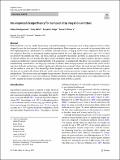| dc.contributor.author | Ghodgaonkar, Aditya | |
| dc.contributor.author | Welsh, Emily | |
| dc.contributor.author | Judge, Benjamin | |
| dc.contributor.author | Winter V, Amos G. | |
| dc.date.accessioned | 2025-01-06T18:27:05Z | |
| dc.date.available | 2025-01-06T18:27:05Z | |
| dc.date.issued | 2025-01-04 | |
| dc.identifier.uri | https://hdl.handle.net/1721.1/157945 | |
| dc.description.abstract | With freshwater reserves rapidly diminishing, sustainable irrigation technologies such as drip irrigation must be widely adopted to meet the food demand of a growing global population. Drip irrigation uses a network of pressurized tubes with flow-regulating devices called emitters to minimize conveyance losses, saving up to 65% water compared to flood and furrow irrigation. However, its widespread adoption remains limited due to its high initial capital costs, up to 55% of which are driven by the emitters and tubes. The plastic material consumed by the emitters and tubes is a major driver of their cost. To directly address this cost barrier, this paper details a hydraulic design theory for compact emitters having a common commercial architecture: uniform depth labyrinths with symmetric, triangular teeth. The theory uses geometric symmetry, manufacturing considerations, and clogging constraints to identify three design parameters in emitters that can be used to tune their hydraulic performance without significantly affecting their material volume: the tooth tip gap, labyrinth depth, and the number of tooth pairs. This knowledge allows designers to minimize emitter volume and set architecture a priori, and then use an empirically derived hydraulic model that uses the selected parameters as input arguments to tune flow rate independently. This ensures faster and simpler design iterations. The theory enabled a reduction in emitter material consumption by 67% compared to at least one commercial emitter, potentially cutting the initial capital cost of drip irrigation by up to 10%, making this already sustainable irrigation technology more globally accessible. | en_US |
| dc.publisher | Springer Berlin Heidelberg | en_US |
| dc.relation.isversionof | https://doi.org/10.1007/s00271-024-00987-7 | en_US |
| dc.rights | Creative Commons Attribution | en_US |
| dc.rights.uri | https://creativecommons.org/licenses/by-nc-nd/4.0/ | en_US |
| dc.source | Springer Berlin Heidelberg | en_US |
| dc.title | An empirical design theory for compact drip irrigation emitters | en_US |
| dc.type | Article | en_US |
| dc.identifier.citation | Ghodgaonkar, A., Welsh, E., Judge, B. et al. An empirical design theory for compact drip irrigation emitters. Irrig Sci (2025). | en_US |
| dc.contributor.department | Massachusetts Institute of Technology. Department of Mechanical Engineering | en_US |
| dc.relation.journal | Irrigation Science | en_US |
| dc.identifier.mitlicense | PUBLISHER_CC | |
| dc.eprint.version | Final published version | en_US |
| dc.type.uri | http://purl.org/eprint/type/JournalArticle | en_US |
| eprint.status | http://purl.org/eprint/status/PeerReviewed | en_US |
| dc.date.updated | 2025-01-05T04:11:57Z | |
| dc.language.rfc3066 | en | |
| dc.rights.holder | The Author(s) | |
| dspace.embargo.terms | N | |
| dspace.date.submission | 2025-01-05T04:11:57Z | |
| mit.license | PUBLISHER_CC | |
| mit.metadata.status | Authority Work and Publication Information Needed | en_US |
